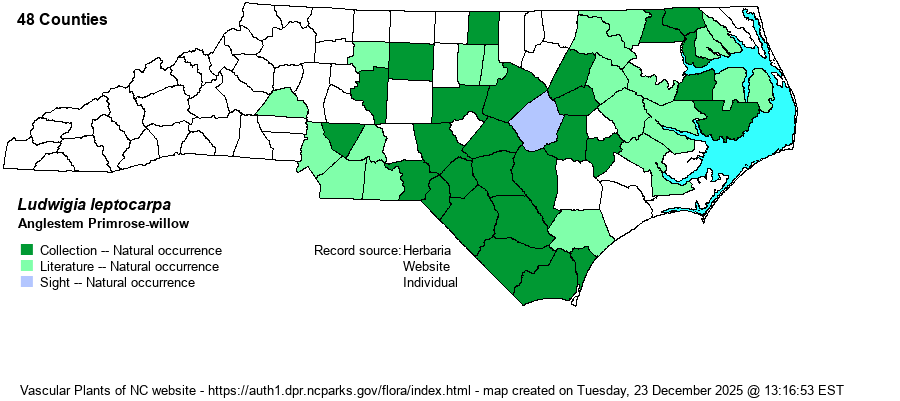| Author | (Nuttall) Hara | |
| Distribution | This is a species originally found (mainly or solely) in the Coastal Plain, including the Sandhills region. It also ranges west now (2025) into the central Piedmont, west to Forsyth and Catawba counties. It formerly was very spotty in the northeastern half of the Coastal Plain, but it is expanding into the northeastern Coastal Plain in the past decade or two, based on numerous photo records on iNaturalist.
This is a Southeastern species found from MD and OK south to the Gulf Coast. However, it is mainly absent from montane regions.
| |
| Abundance | Clearly increasing in the state in recent years, and now common in the Sandhills region and southeastward to the coast. Locally fairly common in the extreme eastern Piedmont, but rare though still increasing westward into the central Piedmont. Uncommon but increasing in the eastern part of the Coastal Plain. Weakley (2024) shows it as not native in the Piedmont of VA and NC; however, it does appear to be native at least in Wake, Chatham, and Anson counties; and yes, the species has only recently "invaded" much of the Piedmont, but where does one stop the Natural range and then consider others as Provenance uncertain or even Non-Natural? For now, this website will not consider records as Non-Natural, as the species is moving westward (by whatever means). The website editors believe that this species is now common enough to be ranked as S4 as opposed to the NCNHP's S3 State Rank. Sorrie (2011) calls it "common" in the Sandhills, though his book also covers the region into SC and GA. | |
| Habitat | This species has habitats very similar to other large Ludwigia species -- wet ground of swamp openings, lake and pond margins and shores, marshes, and river banks. Weakley (2018) says "often on logs or tree bases in deep swamps". | |
| Phenology | Blooms from June to September, and fruits shortly after flowering. | |
| Identification | This is a rather robust herb, growing erect with a densely pubescent stem and several branches, to about 3 feet tall. The alternate leaves are typical of the genus, being lanceolate to elliptic, about 4-5 inches long and about 1-inch wide, tapered to both ends, but with no obvious petiole. Though the numerous flowers are in leaf axils, this species has very long and slender floral tubes that average about 1.5 inches long, making for a most unusual flower. The flower contains 5-7 bright yellow petals, fairly small and rounded, and the front of the flower is only about 2/3-inch across. (Thus, the flower is much longer than wide at the front). This species should be easy to identify by its very pubescent but non-winged stem, very long floral tubes, and 5-7 yellow petals. A few non-native species can have 5 or more yellow petals, but they do not have long floral tubes. As mentioned above, this species definitely seems to be increasing, perhaps adapting well to beaver ponds, reservoirs, and other pond shores and marshes. It is hoped that in upcoming years, more biologists will conduct field work and/or do more collecting in marshes and other such (non-savanna) wetlands in the northern half of the Coastal Plain, as so little of that is happening in recent years. | |
| Taxonomic Comments | This is one of several species formerly placed in the genus Jussiaea.
| |
| Other Common Name(s) | None | |
| State Rank | S3 [S4] | |
| Global Rank | G5 | |
| State Status | | |
| US Status | | |
| USACE-agcp | OBL link |
| USACE-emp | OBL link |

